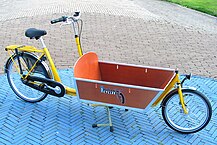| Cargo bike | |
|---|---|
 Modern long-wheelbase cargo bike from Amsterdam | |
| Classification | Vehicle |
| Application | Transportation |
| Fuel source | Human-power, Motor-power |
| Wheels | 2–4 |
| Axles | 0–2 |
| Components | Frame, Wheels, Tires, Saddle, Handlebar, Pedals, Drivetrain, Cargo area |
| Examples | Butcher's bike, Porteur, Cycle truck, Boda-boda, Stroller bike, Long john, Off-road long john, Longtail, Wooden |
| Types | Bicycle, Tricycle, Quadracycle |
| Uses | Delivery services, Mail delivery, Transporting children, Food vending, Tool transport, Airport cargo handling, Recycling collection, Warehouse inventory transportation |
There have been many human powered vehicles designed and constructed specifically for transporting loads since their earliest appearance in the 20th century. They are referred to variously depending on the number of wheels — typically two, three, or four — and by their specific use. Adjectives used to describe the tasks to which the bicycles, dicycles, tricycles, or quadracycles are put include cargo cycles (bi- / tri- / etc.), freight cycles, box cycles (due to the luggage carrier's shape), carrier cycles, and so on. Sometimes they are also called cycletrucks, which uses a sense of the word 'truck' predating the automobile.
Cargo bike designs include a cargo area consisting of an open or enclosed box, a flat platform, or a wire basket, usually mounted over one or both wheels, low behind the front wheel, or between parallel wheels at either the front or rear of the vehicle. The frame, drivetrain and wheels must be constructed to handle loads larger than those on an ordinary bicycle.